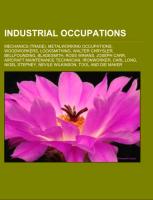Industrial occupations
BücherAngebote / Angebote:
Source: Wikipedia. Pages: 51. Chapters: Mechanics (trade), Metalworking occupations, Woodworkers, Locksmithing, Walter Chrysler, Bellfounding, Bladesmith, Ross Winans, Joseph Carr, Aircraft Maintenance Technician, Ironworker, Carl Long, Nigel Stepney, Nevile Wilkinson, Tool and die maker, Charlie Taylor, Ken Wright, Harry Hartz, Tom Barrett, Millwright, Auto mechanic, Sawfiler, Lu Ban, Stationary engineer, Leon D. Cuddeback, Bicycle mechanic, Instrument mechanic, Giuseppe Maggiolini, Welder, Wheelwright, Anton Seuffert, Plumber, Aviation Structural Mechanic, Maintenance engineering, Boilermaker, Erv Kanemoto, John William Kitson, Lucian Ercolani, Engie Benjy, Münzmeister, Albert F. Woller, Dudley Laws, Sympson the Joiner, Panel beater, Marko Penov, Soaper, List of metalworking occupations, Building and Wood Workers' International, John Boson, Gas jockey, Robert Ellin, Münzwardein, Shipfitter, Erno Garami, Construction Mechanic, Charles Taylor Master Mechanic Award, Elevator mechanic, André Jacob Roubo, Bobbin boy, Plant operator, Paul Sellers, Beader, Hermann Steiner, Moldmaker, Heinouchi Yoshimasa, Robert Hamada, Clerk of the Chapel, Stevenson and Higgins. Excerpt: Bellfounding is the casting of bells in a foundry for use in churches, clocks, and public buildings. A practitioner of the craft is called a bellmaker or bellfounder. The process in Europe dates to the 4th or 5th century. In early times, when a town produced a bell it was a momentous occasion in which the whole community would participate. Archaeological excavations of churchyards in Britain have revealed furnaces, which suggests that bells were often cast on site in pits dug in the building grounds. In some instances bells were cast directly in the church. Before the nineteenth century, bellfounders tended to be itinerant, traveling from church to church to cast bells on site. It wasn't until the creation of railroads, that more centralized foundries were established. There are however examples of foundries producing bells prior to this, such as the Whitechapel Bell Foundry. Bells intending to be rung are usually made by casting bell metal (a high-copper bronze alloy) of a size appropriate for the pitch the bell is intended to produce. Fine tuning of metal bells is achieved on a lathe where a precise amount of material is removed from the inside of the bell in order to produce a true tone with correct harmonics. Bells are used often to play a chime sequence and so must be well tuned in order to produce a correct scale of musical notes. Bellfounding has had an crucial role throughout the history of ancient civilizations. Eastern bells, known for their tremendous size, were some of the earliest bells, cast many centuries before the European Iron Age. Portable bells came to Britain with the spread of Celtic Christianity, and most of these still remaining share an association with Scotland, Wales and Ireland. Bells are traditionally cast in foundries for use in churches, clocks, and public buildings. A practitioner of the craft is called a bellfounder or bellmaker. Bellfounding in Britain, as with other scientific crafts, had its origins with monasticism and throughout
Folgt in ca. 5 Arbeitstagen
